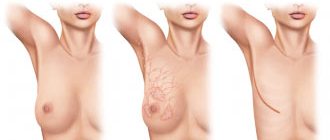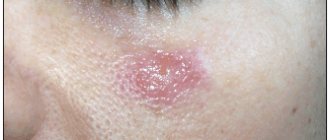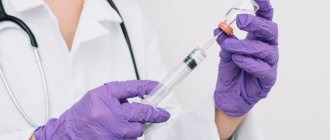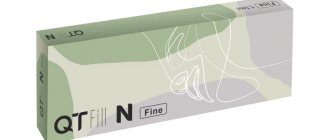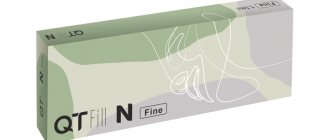Until non-steroidal anti-inflammatory drugs began to be actively used in the treatment of various diseases of the musculoskeletal system, glucocorticosteroids were mainly used in the drug therapy of these pathologies.
Currently, this group of drugs has receded into the background, but in some cases these drugs are still prescribed by doctors in connection with certain indications. Glucocorticosteroids have lost their popularity due to the fact that these drugs have a lot of side effects, and there is a very extensive list of contraindications for their use. In some cases, when treating osteochondrosis with severe pain syndromes, the prescription is advisable. Currently, one of the most effective and widespread glucocorticosteroids is the drug “Diprospan”.
"Diprospan" injections: reviews for osteochondrosis
In the article we will look at Diprospan injections: reviews for osteochondrosis, indications and contraindications for this drug, as well as rules for administration.
Pharmacological action and composition of the drug
Betamethasone is the main active component of this drug.
Important! The drug has two release forms, one of which is aimed at quickly achieving a therapeutic effect, and the other provides a prolonged effect.
The drug is available in the form of ampoules of one milliliter. The consistency of the drug should be slightly viscous.
The main component of Diprospan is betamethasone
Compound.
- Betamethasone disodium phosphate – 2 milligrams.
- Betamethasone dipropionate – 5 milligrams.
The drug has high glococorticosteroid activity. It also contains slight corticoid activity. This drug has a pronounced anti-inflammatory effect, which is necessary in the treatment of osteochondrosis. The composition of the drug allows it to effectively influence areas of inflammation and suppress the development of the inflammatory process in them.
In addition, Diprospan also has an immunomodulatory and anti-shock effect. The effect of the drug occurs within ten to twenty minutes after its administration, which is why Diprospan is widely used to relieve acute pain, as well as as an emergency anti-shock drug. After administration of the suspension, the drug continues to act in the body for another three days.
Indications
Before prescribing glucocorticosteroids to a patient, the doctor must fully study his medical history, symptoms, and pathologies. This is necessary because in many cases this group of drugs can be prescribed in addition to existing therapy, since treatment with glucocorticosteroids alone may be ineffective.
"Diprospan" refers to glucocorticosteroids
Diseases for which glucocorticosteroids are prescribed:
- osteochondrosis of the spine, regardless of its location;
- rheumatoid arthritis;
- inflammatory processes of soft tissues and ligaments.
There are also a number of diseases for which glucocorticosteroids are used as additional therapy, including:
- allergies;
- skin lesions;
- renal failure;
- connective tissue damage.
“Diprospan” is especially effective for pathologies of the locomotor system, including osteochondrosis
Contraindications
A group of drugs such as glucocorticosteroids has a fairly large number of contraindications. The main pathologies for which the use of glucocorticosteroids is contraindicated:
- mycoses;
- allergies to components and hypersensitivity to components of the drug;
- intra-articular administration of the suspension is contraindicated if the patient has infectious arthritis.
Also, glucocorticosteroids are contraindicated in children.
Pathologies and conditions in which glucocorticosteroids should be used with caution:
- infections and parasitic diseases of any etiology. In this case, diseases suffered throughout life and contacts with a sick person are taken into account;
- patients with severe infectious diseases are allowed to take glucocorticosteroids only as an auxiliary therapy against the background of the main treatment;
- in the period before and after vaccination;
- HIV infections;
- patients who have or have previously had any pathologies of the gastrointestinal tract;
- renal failure;
- pathologies of the cardiovascular system;
- liver failure;
- patients who have third or fourth degree obesity.
It is important to consider contraindications before using the medicine
If, upon the first administration of the drug "Diprospan", the drug did not show the proper analgesic effect or the effect was short-term, then the subsequent administration of this drug is considered inappropriate.
The drug should not be administered into the space between the vertebrae or into infected areas.
Diprospan after rhinoplasty
Diprospan is often prescribed after rhinoplasty. Diprospan is a hormonal drug, and patients always have many questions regarding this drug.
The main question is, is it safe? Will a person get better when using it? Will there be any unevenness or depression of the skin above the injection site? Is it possible to do secondary rhinoplasty if you don’t like the result of the primary rhinoplasty, and during the rehabilitation period the doctor administered Diprospan?
What is Diprospan?
First you need to figure out what kind of drug Diprospan is? This is a hormonal drug, the active ingredient of which is betamethasone - a synthetic glucocorticosteroid, an analogue of natural hormones (cortisol, cortisone) produced in the adrenal cortex.
Glucocorticosteroids have a main property - they have a powerful anti-inflammatory and anti-edematous effect. And there are no other substances in the pharmaceutical industry that have a similar anti-edematous effect. Therefore, Diprospan is prescribed to patients after nose surgery.
Another important property of glucocorticosteroids is that they have catabolic activity. Diprospan reduces the formation of granulation and connective tissue, and, therefore, inhibits the process, which can negatively affect the effect of rhinoplasty and lead to the formation of pathological scars.
Injections of Diprospan into the soft tissues of the tip of the nose help prevent severe scarring. If scars have already formed after rhinoplasty, injections of the drug can reduce their severity and eliminate this aesthetic defect as much as possible.
Reasons for using Diprospan after rhinoplasty are:
- Reduction of swelling, mainly in the area of the tip of the nose.
- Prevention of severe scarring.
- Reduction in the size of pathological postoperative scars.
Is Diprospan dangerous?
In short, no. However, there are many myths and questions surrounding hormonal drugs that it is necessary to answer this question in as much detail as possible.
What are the specifics of using the drug Diprospan?
Many patients are concerned that Diprospan is a hormonal drug. Unlike the systemic use of this kind of drugs used to treat hormonal imbalances, diabetes, infertility and other diseases, Diprospan does not affect all organs.
It is applied topically only to a small area of tissue. It penetrates poorly into the bloodstream, so it has no overall effect on the body. Systemic action is possible only with large dosages, but the medicine is immediately stopped after swelling decreases.
Side effects: myths and reality
We found out that Diprospan does not have a systemic effect after rhinoplasty. What does this mean in practice? In practice, this means that many of the side effects that plastic surgery patients fear do not and cannot exist.
For example, some are frightened by the prospect of “getting better on hormones.”
To achieve a similar effect, you need to use drugs with systemic action in high doses and over a long period. After one or two injections of Diprospan into the nasal tissue, weight gain is impossible even in theory.
Decreased immunity is another imaginary threat.
Yes, corticosteroids are used in official medicine as immunosuppressants. With their help, doctors reduce the severity of unwanted immune reactions. Allergists include betamethasone in treatment regimens for bronchial asthma. It is important to understand that in order to suppress immune reactions, it is necessary to inject Diprospan intramuscularly and administer it in doses that provide a systemic effect. Such dosages are not used after nose surgery. Moreover, the drug has a beneficial effect on the functioning of the immune system, reduces the risk of allergic reactions, and works as an anti-shock agent. Thanks to the high concentration of betamethasone disodium phosphate, all regenerative processes are accelerated significantly.
The third group of concerns is associated with the possible formation of dimples or “dents” at the injection site (as a rule, Diprospan injections are made into the tip of the nose or into the skin above it).
Here we must admit that such an effect is possible. Betamethasone has a pronounced catabolic effect, which means that it can provoke atrophy of the soft tissues of the nose. An aesthetic defect in the form of skin unevenness may indeed form above the injection area.
An injection of diprospan into the nose during rhinoplasty is prescribed by the attending physician if it is necessary to quickly eliminate large swelling. It is strictly forbidden to inject yourself, as it is dangerous to health.
Reviews from patients about diprospan after rhinoplasty claim that the patient does not experience any unpleasant sensations when the drug is administered. There is no need to inject painkillers into the swollen tissue before injections. The plastic surgeon injects a small dose of the drug locally into each area of swelling, which speeds up the process of tissue restoration.
Among the main advantages of using modern methods of combating edema are the following:
- instant penetration into damaged tissue gives a quick positive effect, helping to neutralize the spread of edema;
- swelling disappears several times faster, preventing the formation of unsightly scars at the healing site.
Important. An injection after rhinoplasty dramatically reduces the appearance of new swelling or bruising, stimulates tissue restoration, and has a positive effect on regeneration processes. But if used incorrectly, the drug can lead to retraction of the nasal tissue.
Possible side effects when using diprospan after rhinoplasty
It is necessary to use the drug only in a hospital under the supervision of the attending physician, since negative effects may occur that negatively affect the body. For most patients, Diprospan injections after rhinoplasty are absolutely harmless, but there are a number of side effects that you need to be aware of.
- A sudden loss of appetite, accompanied by attacks of nausea, is possible.
- If the dosage is incorrect, otheoporosis may occur, since the medicine affects the absorption of calcium.
- The appearance of unreasonable anxiety, leading to panic, prolonged depression.
- Unmotivated pressure surges.
- A decrease in the body's resistance to infectious diseases, which is dangerous during the spread of influenza or ARVI.
- Rapid weight gain, which can lead to obesity.
- Failure of the menstrual cycle.
- Increased excitability, leading to insomnia.
Diprospan after rhinoplasty is prescribed by the attending physician if the swelling lasts a long time and the recovery process is sluggish. The specialist independently regulates the dosage and depth of injections in order to achieve the maximum positive effect while minimizing possible risks.
How is the injection given after rhinoplasty?
According to the method of carrying out the procedure, the effect is reminiscent of mesotherapy. Thanks to the use of very thin needles, the patient does not feel pain.
The depth of penetration is regulated by the doctor, always insignificant. Only swollen areas are treated. A small drop of blood may appear at the injection site. The effect accumulates over 3-5 days. The medicine remains in the problem area for up to 2 months, accelerating tissue healing processes. The suspension, entering the area of edema, does not spread to neighboring tissues, acting strictly on the local area.
Numerous positive reviews on the effect of diprospan after rhinoplasty confirm the effectiveness of the drug in postoperative recovery of the body. When prescribing injections, the attending physician must take into account the general condition, weight, complexity of rhinoplasty, and other factors influencing the dosage and duration of treatment.
"Diprospan" for osteochondrosis
When treating osteochondrosis, many doctors decide to prescribe glucocorticosteroids to the patient. Most often, they rely on their clinical experience to select the right drug. The drug "Diprospan" quickly gained the trust of specialists, since its first applications have already begun to show fast and effective results. The drug received positive reviews not only from doctors, but also from the patients themselves, who experienced its effective effect. This drug has one positive quality that distinguishes it from other drugs in this group. “Diprospan” not only quickly eliminates pain, but is also a good prophylactic against possible complications. The drug received this quality due to its unique composition.
This drug, after entering the human body, begins to block the inflammatory process. Substances that contribute to the development of inflammation fall under the action of the drug substances and lose their ability to provoke a further inflammatory reaction.
This remedy successfully fights the manifestations of osteochondrosis
It must be remembered that glucocorticosteroids can be used in the treatment of osteochondrosis only to relieve pain. These medications cannot eliminate the causes of the disease itself.
With such drug therapy, specialists usually prescribe the additional use of chondroprotective drugs. This is due to the fact that long-term use of glococorticosteroids can negatively affect the condition of the joints, causing the destruction of joint tissue.
Treatment of scars with Diprospan
The main feature of the procedure is the unique composition of the drug, the components of which have a suppressive effect on the processes of tissue proliferation. Thanks to this, scar growth stops and inflammatory processes are eliminated. As a result, the size of the scar is noticeably reduced.
Scars that have recently formed are the easiest to treat and often require only one session to remove them. If the scar is more than a year old, then most likely it will require several sessions to remove it. Complex treatment is also sometimes used, in which the injection procedure is supplemented with laser ones. For example, bunker or Fraxel.
Preparation for the procedure
To carry out the treatment procedure using Diprospan (or Kenalog) injections, there is no need for any special preparation. However, you will need to visit a dermatocosmetologist in advance. This is necessary for a specialist to conduct a short consultation on the injection treatment of the procedure. You can also ask any question about scar treatment. In addition, the doctor will need to examine the scars and interview you. The collected anamnesis will help assess the effectiveness of injections, select the optimal remedy and create a course. And at the initial appointment, the specialist will check whether you have any contraindications to the procedure. Thus, Diprospan injections should not be given to pregnant and lactating women. Viral infections and exacerbation of any skin diseases are also contraindications. In addition, it is prohibited to carry out the procedure if there is a history of cancer.
It won’t hurt to inform your doctor at the consultation about any chronic diseases you have, as well as allergies to medications.
But if you do not have any of the above restrictions, then the session can be held immediately after the consultation.
Carrying out the procedure for injection treatment of scars
To carry out the procedure, there is no need to anesthetize the skin with a scar, since the session is performed quite comfortably and without anesthesia. Before administering the drug, the doctor will treat the skin with an antiseptic to eliminate the risk of infection. After this, they move directly to injections: to evenly distribute the composition, several small injections are made directly into the scar. As a rule, the duration of one session does not exceed twenty minutes. When it is over, the specialist will again treat the skin with an antiseptic and give recommendations for the post-procedure period.
Treatment of scars with injections: post-procedure period
After the administration of Diprospan injections, no rehabilitation will be required for scars, so you can immediately return to everyday life without being distracted from work or school. However, you will need to adhere to general guidelines:
- In the first two weeks, you should not sunbathe either in the solarium or on the beach.
- Also, during the week you cannot go to steam rooms, saunas and baths.
- In the first days, you need to treat the scar with Dermatix.
In addition, experts recommend, if possible, not to scratch the skin at the injection site. In some cases, in addition to general prescriptions, doctors also give individual ones. To get the maximum result from the procedure and minimize the risk of side effects, you need to follow all the specialist’s recommendations.
Methods of using Diprospan
There are several methods of administering this drug:
- intramuscularly;
- intra-articular injection;
- periarticular injection into soft tissues;
- intradermally.
Important! The drug is contraindicated for intravenous and subcutaneous administration. The dosage and duration of the course of use are selected by a specialist for each patient individually. In this case, the diagnosis, the degree of damage by the disease, as well as concomitant pathologies must be taken into account.
The standard course of glucocorticosteroid therapy is one to five injections, followed by an interval of one week. After the desired effect of the drug is achieved, the dosage is gradually reduced to the minimum. Only after bringing the dose to the very minimum can the drug be discontinued. If the symptoms of the disease return at the minimum dosage, then the dose of the drug is increased again.
Typically, Diprospan is administered intramuscularly.
If Diprospan is used as a blockade, the drug must be diluted with lidocaine or novocaine. The choice of drug depends on the patient’s tolerance, which is individual for each patient. If during the administration of the drug the patient experiences pain at the injection site, then before administration the injection site must be treated with a local anesthetic.
Important! "Diprospan" is a long-acting drug. The components of this drug remain in the patient’s body for another ten days after its administration, which is why Diprospan should be used no more than once every fourteen to thirty days.
Introduction
In 2022, humanity is faced with a new threat in the form of COVID-19.
The entire medical community has mobilized to fight the pandemic. The accumulated knowledge and experience have allowed us to stabilize the situation in terms of morbidity and mortality. While the world's population is waiting for the next wave of COVID-19, doctors are eliminating the consequences of the pandemic - those complications that have arisen in patients with previous (symptomatic or asymptomatic) coronavirus infection. The issues of post-Covid syndrome are currently being actively debated in the scientific world [1]. During the height of the pandemic, our outpatient practice began to encounter patients with arthritis of different localizations and varying degrees of severity of clinical manifestations, resistant to traditional therapy with nonsteroidal anti-inflammatory drugs (NSAIDs). What united such patients was a previous coronavirus infection. Often, the patients in question initially turned to specialists of a different profile and received symptomatic treatment for osteochondrosis, coxarthrosis, tendovaginitis, etc. Infectious etiology, as a rule, was not considered as a trigger for the occurrence of inflammation in the joints. If there was no therapeutic effect, a new NSAID was often recommended. To date, a large number of reviews of the practical application and effectiveness of drugs for the treatment of coronavirus infection have been published [2]. During the pandemic, as experience was gained, algorithms for providing care to patients with COVID-19 changed. However, neither in the domestic nor in the foreign literature the issues of diagnosis and treatment of arthritis against the backdrop of a coronavirus infection have been covered, which means that treatment algorithms for such complications have not been developed. In the absence of clinical recommendations for the treatment of complications from the musculoskeletal system against the background of a coronavirus infection and the resistance of arthritis to NSAIDs (according to our observations), we began to use glucocorticosteroids (GCS) to relieve clinical manifestations of inflammation. This group of drugs is also recommended for the treatment of coronavirus infection [3]. It is well known that GCS block the synthesis of a wide range of pro-inflammatory mediators, an increase in the concentration of which as part of a “cytokine storm” is associated with an unfavorable prognosis in COVID-19 [4]. It should be noted that in the pathogenesis of reactive arthritis, an important role is played by the imbalance of pro-inflammatory cytokines [5], the high content of which (in particular, interleukins) is found in the plasma of patients with coronavirus infection [6], which can be considered as an unrealized “cytokine storm”. We consider previous infection caused by SARS-CoV-2 as a trigger for joint syndrome. In this regard, we began to identify arthritis in patients with a significant history of coronavirus infection as “post-Covid arthritis.”
We present our own experience in treating patients with previous coronavirus infection and manifestations of reactive arthritis, in the treatment of which systemic corticosteroids were successfully used.
Own experience
Under our supervision at the Center for Traumatology and Radiography in Tver there are 916 adult patients who contacted an orthopedic traumatologist with clinical manifestations of arthritis against the background of a previously suffered (symptomatic or asymptomatic) confirmed infection caused by SARS-CoV-2 (M13.9 according to the ICD -10). The average age of the patients was 47.1±11.3 years. The majority of patients are women—773 (84.4%) people.
All patients, without exception, at their initial visit to an orthopedist-traumatologist complained of joint pain at rest and during exercise. Of note was the acute onset of the disease in the majority (92%) of patients (Table 1). Patients often experienced muscle pain and stiffness in the affected segments, worsening in the evening and at night (78.5%), and therefore many patients initially turned to neurologists. More than half of the patients with a positive epidemiological history of COVID-19, who applied for an outpatient orthopedic appointment with joint pain of varying nature and intensity, had typical clinical manifestations of inflammation: effusion (determined by palpation, in some cases confirmed by ultrasound and MRI), swelling and local hyperthermia in the area of the affected segment. However, in a third of patients, visual and palpatory changes were not detected at all. Rarely, those observed had low-grade fever (19.7%) and functional disorders in the form of lameness and restrictions of movement in the affected joint (37.8%).
The most common location of arthritis in the observed patients was the knee joint - 48.2% of cases. Patients were significantly less likely to present with pain in other segments (Table 2). The difference between the number of patients (n=916) and the number of localizations (n=1163) is due to the fact that in 54 (5.9%) cases there was simultaneous damage to several joints. Based on this, we can conclude that in the vast majority of cases the disease occurred in the form of monoarthritis (94.1%).
Pain syndrome in the majority, 628 (68.6%), patients was assessed as moderate - 4-6 points on VAS, 167 (18.2%) patients noted mild pain - 1-3 points on VAS, 121 (13.2%) ) the patient complained of severe pain - over 6 points on VAS.
Seven hundred fifty-one (82%) patients had a history of injury or degenerative disease (osteoarthritis, enthesopathies, hypermobility, dysplastic changes, etc.) of the arthritic joint, but in all cases a different type of pain was noted.
The average time for the onset of arthritis was approximately 6 weeks. from a confirmed case of coronavirus infection (45.0±7.1 days). These figures differ from the average time to contact a specialized specialist - 62.2±12.8 days. Such delayed clinical manifestations, in our opinion, are the main reason for the misinterpretation of articular syndrome. We observed many patients who, before visiting an orthopedist, were examined by doctors of related specialties and underwent expensive examinations that did not facilitate the diagnostic search. At the time of their visit to the clinic, 709 (77.4%) patients used traditional NSAIDs (prescribed by a doctor or used on their own initiative) orally, parenterally or locally as initial therapy for arthritis. This group of patients was asked to answer the question about the effectiveness of using NSAIDs for pain relief. Of the 709 patients surveyed, 560 (79%) reported no improvement in the affected joints while taking NSAIDs. 16% of patients (112 people) experienced short-term improvement, and after stopping the course of NSAID treatment, pain returned. Only 35 (5%) of respondents received the desired effect - a decrease in the severity of pain compared to the initial level. The survey results indicate that arthritis is resistant to NSAIDs. In this regard, we decided to prescribe GCS to patients with clinical manifestations of post-Covid arthritis. As a basic treatment for arthritis against the background of a coronavirus infection, the drug betamethasone (Diprospan®) was used in a dosage of 1 ml, which was administered intramuscularly, taking into account the comorbid background and possible allergic reactions, which in 93 cases served as a contraindication to the administration of the drug. Diprospan® has a pronounced anti-inflammatory effect. The drug is a combination of soluble and poorly soluble betamethasone esters for intramuscular, intraarticular, periarticular, intrasynovial and intradermal administration, as well as for administration directly into the lesion. Betamethasone sodium phosphate is a highly soluble component that is rapidly absorbed from the injection site, which ensures a rapid onset of therapeutic action. Betamethasone dipropionate is a poorly soluble component that is slowly absorbed from the depot created at the injection site and provides a long-lasting effect of the drug.
Control examinations were carried out on the 7th, 14th and 28th days of observation. The effectiveness of treatment was assessed subjectively (severity of pain on the VAS scale) and objectively (dynamics of inflammatory changes).
In total, the drug was prescribed to 823 (89.8%) patients. For 570 (69.3%) people, a single dose of the drug was sufficient. They showed positive dynamics in the form of relief of pain and inflammatory changes in the affected joints. In 112 (13.6%) cases, due to pain remaining at the initial level, repeated administration of the drug at the same dosage was required after 2 weeks. after the first injection. The third injection (2 weeks after the second) was given to 44 patients with insufficient effect from the first two. 97 patients did not return to the clinic after the first injection, which cannot be regarded as a positive result after a single use of betamethasone dipropionate due to the lack of feedback.
In general, there was a persistent decrease in pain in the entire observation group, starting from the 7th day of observation (Fig. 1).
Rules for the introduction of "Diprospan"
If the drug is prescribed for intramuscular administration, one to two milliliters of the drug is usually prescribed. If it must be injected into the periarticular area, in this case zero point two milliliters are injected per square centimeter of the joint surface. If the drug must be administered inside the joint itself, then the dosage is a maximum of two milliliters per injection, the drug is administered no more than once a week.
Side effects of the medicine
- Long-term therapy with this drug can disrupt metabolic processes in the patient's body. Therefore, with long-term use of Diprospan, the patient may notice the appearance of edema due to water retention in the body. Weight gain may also occur.
- On the part of the heart, an increase in blood pressure may be observed. If the medication is taken incorrectly, there is a risk of heart failure.
- Muscles lose their strength and mass, bones become more fragile, and there is a risk of osteoporosis.
- From the digestive system, severe flatulence is observed, and pancreatitis may develop. The walls of the stomach and intestines are affected by ulcers and erosions.
- In the presence of increased intracranial pressure, headaches and dizziness, and decreased vision may be noted. The patient may also suffer from insomnia, constant fatigue, and irritability. In severe cases, depression may develop.
- Intraocular pressure increases, vision sharpness decreases. Possible development of exophthalmos. In rare cases, the patient may lose vision completely.
- The patient’s individual reaction to the medicine can manifest itself in the form of allergies, from hyperemia and urticaria to anaphylactic shock.
- Many patients, after introducing the drug into the body, note a feeling of a sharp rush of blood to the face.
Diprospan has serious side effects
Welts or scars. Scar removal
Hems or scars are a pathological reaction of the skin to an injury with the formation of connective tissue at the site of the damaged area. Scars are a fairly significant aesthetic defect and cause physical discomfort when located in moving areas.
The following types of scars are distinguished:
- normotrophic scars - located at the same level with normal skin, quite elastic, pale pink in color;
- atrophic scars - located below the skin level (retracted into the epidermis), flabby structure; an example would be stretch marks and acne scars;
- hypertrophic scars - protrude above the skin level, have a dense, inelastic structure;
- keloid scars - protrude significantly above the surface of the skin, dense with a bumpy structure and vascular inclusions.
Today, the doctors at our clinic have a range of methods and means for treating scars of various types and sizes.
The most relevant methods of them are:
- Laser treatment is the most effective and radical method for correcting scars and scars, recognized throughout the world.
- Chemical peels - activate natural exfoliation and chemically polish the skin in the area of scar deformation.
- Microcurrents activate intracellular processes of metabolism and regeneration.
Carrying out such procedures makes it possible to reduce the thickness of the stratum corneum, eliminate areas of hyperkeratosis, increase the thickness of the living layers of the epidermis, lighten hyperpigmented areas, which ultimately promotes the resorption of infiltrates, reduces redness, significantly improves the structure of scar tissue, and evens out the skin texture.
The introduction of special balanced cocktails containing biologically active substances into the skin during mesotherapy activates metabolic processes in the scar area, promotes the resorption of compactions and leads to an improvement in the structure of damaged skin.
Injections of the drug " Diprospan " - a long-acting glucocorticoid - into the area of the defect can significantly reduce hypertrophic scars and, in some cases, transfer them to a normotrophic state.
Correction and resurfacing of scars and scars with laser
Our clinic offers two professional laser systems for eliminating all types of scars, except keloids.
- Fotona SP Dynamis ( Fotona Medical Technologies, Slovenia) - the Fotona Er:Yag erbium laser of this installation allows you to perform full-beam and fractional (fragmented) resurfacing to eliminate hypertrophic scars. The impact of the Fotona Nd:Yag neodymium laser allows you to “volumize” tissue in the area of atrophic and normotrophic scars.
- Palomar Star Lux (Palomar Medical Technologies, Inc, USA ) - the Palomar Lux2940 erbium laser is used for fractional laser treatment of hypertrophic and normotrophic scars and scars, and the Palomar Lux1540 attachment is used for fractional photothermolysis procedures for the treatment of all types of scar pathologies.
Laser skin resurfacing involves the removal of old surface layers of cells using a laser, under the influence of which the process of renewal of the cellular composition of the skin is launched and scar tissue is removed. The obvious advantage of this procedure is the ability to dose the laser beam on different areas of the skin with maximum precision.
of fractional photothermolysis techniques using the Palomar Lux1540 non-ablative erbium laser and the Fotona Nd:Yag neodymium laser, unprecedented results are achieved in the treatment of atrophic and normotrophic scars.
The advantages of this method of treating scars are:
- no damage to the stratum corneum of the epidermis when exposed to structures located at a depth of 1.4 mm to 8 mm;
- the ability to lead a normal lifestyle after the procedure; There is only minor swelling and redness, which lasts 1 to 3 days;
- minimum skin care measures after the procedure (use of moisturizers, sun protection).
The key to successful treatment of scars in our clinic is accurate diagnosis, a large selection of treatment methods and their combined use, as well as competent procedures.
- Prices for removal and resurfacing of scars and stretch marks using the Fotona SP Dynamis laser Er:Yag laser technology
- Laser scar resurfacing fractional Fotona Er:Yag/ per 1 cm2
700 rub
- Laser scar resurfacing fractional Fotona Er:Yag from 10 cm2/per 1 cm2
450 rub.
- Fractional treatment of connective tissue, treatment of stretch marks/per 1 cm2
700 rub
- Fractional treatment of connective tissue, treatment of stretch marks, from 10 cm2/per 1 cm2
450 rub.
- Therapeutic combined resurfacing Fotona Er:Yag (severe form of post-acne scars)
18000 rub.
- Neodymium Nd:Yag Laser Technologies
- Regional thermolifting (zone 10x14cm)
6500 rub.
- Combined technologies
- Removal of stretch marks - deep dermal thermolysis + fractional skin resurfacing (1 zone = 15x20 cm)
10000 rub
- Scars, scars, linear stretch marks, size 1-8 cm / per 1 cm of treatment
1400 rub.
700 rub
1400 rub.
- Striae 10x10 cm/per 1 zone
4500 rub.
450 rub.
700 rub
- Modification of atrophic scar tissue of one scar
200 rub
1500 rub.
Reception features
When treating habitual dislocation, it is not recommended to use the drug “Diprospan” as a medicine, since with this problem the medicine will not be able to give a positive effect, so its use in this situation is not advisable.
Important! During the use of glucocorticosteroids, it is necessary to carefully monitor the patient's blood sugar level.
The administration of glucocorticosteroids is contraindicated intravenously or subcutaneously. Insertion into the intervertebral space and intervertebral disc is also not recommended.
It must be remembered that glucocorticosteroids and alcohol are two substances that are incompatible with each other. That is why taking any alcoholic beverages should be stopped several days before starting a course of glucocorticosteroid therapy.
While taking the drug, you must follow certain rules
During the course of drug therapy with Diprospan, the patient must also give up low- and high-alcohol drinks of any kind. This combination of substances in the body can lead to an increase in all the side effects of the drug. When taking alcohol together with glucocorticosteroids, as well as when overdosing on the drug, the patient will experience side effects of this drug, but several times stronger than they exist with normal treatment. The main thing is that in case of an overdose of glucocorticosteroids, the symptoms cannot be relieved with an antidote, because it does not exist. In this condition, the patient is treated symptomatically. The first thing to do is to remove the excess substance from the body using detoxification therapy. It is carried out by infusing the patient with glucose solution intravenously.
Diprospan
Shake before use.
The dosage regimen is set individually, depending on the indications, severity of the disease and the patient’s clinical response to treatment.
Dosage
The dose should be minimal and the period of use should be as short as possible.
The initial dose should be adjusted to obtain a satisfactory clinical effect. If a satisfactory clinical effect is not observed within a certain period of time, treatment should be discontinued by progressive dose reduction and other appropriate therapy should be instituted.
If the response is favorable, the appropriate dose to be followed should be determined, gradually reducing the initial dose at acceptable intervals until the minimum dose with an appropriate clinical response is achieved.
Mode of application
Diprospan suspension is not intended for intravenous or subcutaneous administration.
Systemic application
When used systemically, in most cases, treatment begins with the administration of 1-2 ml of the drug and is repeated if necessary. Dosage and frequency of administration depend on the severity of the patient's condition and response to treatment. The drug is injected deep intramuscularly into the buttock:
- In severe conditions (systemic lupus erythematosus and status asthmaticus) that require emergency measures, the initial dose of the drug may be 2 ml.
- For various dermatological diseases, as a rule, 1 ml of the drug administered intramuscularly is sufficient; administration of the drug can be repeated, depending on the response to treatment.
- For diseases of the respiratory system, symptom relief is achieved within a few hours after injection of the drug Diprospan. For bronchial asthma, hay fever, allergic bronchitis and allergic rhinitis, a significant improvement in the condition is achieved after administration of 1-2 ml of the drug.
- For acute and chronic bursitis, the dose for intramuscular administration is 1-2 ml of the drug. If necessary, carry out several repeated injections.
Local application
The simultaneous use of a local anesthetic is necessary only in rare cases (the injection is practically painless). If simultaneous administration of an anesthetic is desired, Diprospan can be mixed (in a syringe rather than in a vial) with a 1% or 2% solution of lidocaine hydrochloride or procaine hydrochloride or similar local anesthetics using paraben-free dosage forms. It is not allowed to use anesthetics containing methylparaben, propylparaben, phenol and other similar substances. When using an anesthetic in combination with the drug Diprospan, first draw the required dose of the drug into a syringe from the bottle, then draw the required amount of local anesthetic into the same syringe and shake the syringe for a short period of time.
For acute bursitis (subdeltoid, subscapular, ulnar and anterior patella), injection of 1-2 ml of Diprospan into the synovial bursa relieves pain and completely restores mobility in a few hours.
Treatment of chronic bursitis is carried out with smaller doses of the drug after relief of acute symptoms of the disease.
In acute tenosynovitis, tendinitis and peritendinitis, one injection of the drug Diprospan can alleviate the patient’s condition; in chronic cases, repeated administration of the drug may be required depending on the patient’s condition.
For rheumatoid arthritis and osteoarthritis, intra-articular administration of the drug in a dose of 0.5-2 ml can reduce pain, tenderness and joint stiffness within 2-4 hours after administration. The duration of the therapeutic effect of the drug varies significantly and can be 4 or more weeks. Intra-articular administration of the drug Diprospan is well tolerated by the joint and periarticular tissues.
Recommended doses of the drug when administered into large joints (for example, knee, hip) are 1-2 ml; in the middle (for example, elbow) – 0.5-1 ml; in small ones (for example, carpal) - 0.25-0.5 ml.
In the case of dermatological diseases, intradermal injection of the drug directly into the lesion is effective. The response of some lesions that are not directly treated may be due to a small systemic effect of the drug. Inject 0.2 ml/cm2 of the drug Diprospan into the skin (not under the skin) using a tuberculin syringe and a 26 G needle. The total amount of the drug injected into the injection site should not exceed 1 ml.
Leg diseases sensitive to corticosteroids. You can overcome bursitis under the callus with two consecutive injections of 0.25 ml each. Conditions such as bunion toe (bending contracture of the big toe), bunion varus (inward deviation of the fifth toe), and acute gouty arthritis can provide relief very quickly. For most injections in the foot, a tuberculin syringe with a 25 G needle 1.9 cm long is suitable.
Recommended doses of the drug Diprospan (with intervals between injections of approximately 1 week): for bursitis under the callus - 0.25-0.5 ml; for heel spurs – 0.5 ml; for stiffness of the big toe – 0.5 ml; for varus toes – 0.5 ml; for synovial cyst – 0.25-0.5 ml; for Morton's metatarsalgia - 0.25-0.5 ml; for tenosynovitis – 0.5 ml; for inflammation of the cuboid bone - 0.5 ml; for acute gouty arthritis – 0.5-1 ml.
Interaction with other drugs
Glucocorticosteroids are not recommended for use simultaneously with NSAIDs. This is due to the fact that non-steroidal anti-inflammatory drugs, which have a strong impact on the patient’s gastrointestinal tract during their use, in contact with glucocorticosteroids further enhance this effect. As a result, the patient may develop a stomach ulcer, and if there are existing lesions of the gastric walls, there is a risk of perforation of the ulcer and gastric bleeding.
If a patient who is prescribed glucocorticosteroid therapy is taking the hormone estrogen, then the doctor will need to change the dosage of the drug in accordance with the individual patient, since in this case there is a risk of overdose.
Important! The use of diuretics in combination with glucocorticosteroids is impossible. Diuretics remove potassium from the body in large quantities. This can lead to the development of hypokalemia in the patient, since some glucocorticosteroids, including Diprospan, can also increase the release of potassium from the body.
It is important to know whether Diprospan can be combined with other drugs
The use of anticoagulant drugs together with glucocorticosteroids may affect blood clotting or lead to thickening. With this combination, adjustment of the dosage of the drug is also required.
Overdose of glucocorticosteroids
Exceeding the dosage of glucocorticosteroids, as a rule, cannot lead the patient to life-threatening conditions. But at the same time, there are a number of conditions requiring emergency care that can develop with an overdose of glucocorticosteroids. This condition can occur in a patient with diabetes, which is why blood sugar levels must be monitored throughout treatment, even in those patients who have never suffered from high sugar. Also, taking these drugs can lead to stomach or intestinal bleeding in patients who have stomach or intestinal ulcers.
An overdose of Diprospan may result in an unpleasant condition
Diprospan®
Severe nervous system complications (including death) have been reported with epidural and intrathecal administration of GCS (with or without fluoroscopic guidance), including spinal cord infarction, paraplegia, quadriplegia, cortical blindness and stroke. Since the safety and effectiveness of epidural corticosteroids have not been established, this route of administration is not indicated for this group of drugs.
Recommended routes of administration are listed in the "Method of administration and dosage" section. Intravascular administration of the drug must be avoided.
Due to the lack of data regarding the risk of calcification, injection of the drug into the intervertebral space is contraindicated.
The dosage regimen and route of administration are determined individually, depending on the indications, severity of the disease and patient response.
The dose should be as small as possible and the period of use as short as possible. The initial dose is adjusted until the desired therapeutic effect is achieved. Then gradually reduce the dose of Diprospan® to the minimum effective maintenance dose. If there is no effect from the therapy or if it is used for a long time, the drug is also discontinued, gradually reducing the dose.
If a stressful situation (not related to the disease) occurs or threatens to occur, it may be necessary to increase the dose of Diprospan®.
The patient's condition is monitored for at least one year after completion of long-term therapy or use in high doses.
Administration of the drug into soft tissues, into the lesion and intra-articularly can, with a pronounced local effect, simultaneously lead to a systemic effect.
Considering the likelihood of developing anaphylactoid reactions with parenteral administration of GCS, the necessary precautions should be taken before administering the drug, especially if the patient has a history of allergic reactions to drugs.
The drug Diprospan® contains two active substances - betamethasone derivatives, one of which - betamethasone sodium phosphate - quickly penetrates the systemic circulation, and therefore its possible systemic effect should be taken into account.
While using the drug Diprospan®, mental disorders are possible (especially in patients with emotional instability or a tendency to psychosis).
When using the drug Diprospan® in patients with diabetes mellitus, adjustment of hypoglycemic therapy may be required.
Patients receiving corticosteroids should not be vaccinated against smallpox. Other immunizations should not be carried out in patients receiving GCS (especially in high doses), due to the possibility of developing neurological complications and a low immune response (lack of antibody formation). However, immunization is possible during replacement therapy (for example, with primary adrenal insufficiency).
Patients receiving Diprospan® in doses that suppress the immune system should be warned about the need to avoid contact with patients with chickenpox and measles (especially important when using the drug in children).
It is possible to suppress the reaction when performing skin tests during the use of GCS.
When using the drug Diprospan®, it should be taken into account that GCS can mask signs of an infectious disease, as well as reduce the body's resistance to infections.
It is necessary to carefully observe the rules of asepsis and antisepsis when administering the drug.
Caution must be exercised when using the drug in patients at high risk of infection (on hemodialysis or with dentures).
The use of the drug Diprospan® for active tuberculosis is possible only in cases of fulminant or disseminated tuberculosis in combination with adequate anti-tuberculosis therapy. When using the drug Diprospan in patients with latent tuberculosis or during the period of the tuberculin test, the dose selection of the drug Diprospan® should be very careful (due to the danger of reactivation of tuberculosis), and with long-term use, anti-tuberculosis chemoprophylaxis is necessary. When using rifampicin prophylactically, acceleration of the hepatic clearance of betamethasone should be taken into account (betamethasone dose adjustment may be required).
If there is fluid in the joint cavity, a septic process should be excluded. A noticeable increase in pain, swelling, increased temperature of the surrounding tissues and further limitation of joint mobility indicate septic arthritis. It is necessary to conduct a study of aspirated joint fluid. Once the diagnosis is confirmed, appropriate antibacterial therapy must be prescribed. The use of Diprospan® in septic arthritis is contraindicated.
Repeated injections into a joint for osteoarthritis may increase the risk of joint destruction. The introduction of GCS into the tendon tissue gradually leads to tendon rupture.
After successful intra-articular therapy, the patient should avoid overloading the joint.
Long-term use of corticosteroids can lead to posterior subcapsular cataracts (especially in children), glaucoma with possible damage to the optic nerve, and may contribute to the development of secondary eye infections (fungal or viral).
It is necessary to periodically conduct an ophthalmological examination, especially in patients receiving Diprospan® for more than 6 months.
The use of medium and high doses of corticosteroids can lead to increased blood pressure, sodium and fluid retention in the body, and increased excretion of potassium from the body (these phenomena are less likely when taking synthetic corticosteroids, unless they are used in high doses). With long-term use of high doses of Diprospan®, the risk of developing arrhythmia and hypokalemia should consider the need to prescribe potassium-containing drugs and a diet with limited salt. All corticosteroids enhance calcium excretion.
When using the drug Diprospan® simultaneously with cardiac glycosides or drugs that affect the electrolyte composition of plasma, monitoring of the water-electrolyte balance is required.
Use acetylsalicylic acid with caution in combination with the drug Diprospan® for hypoprothrombinemia.
The effect of GCS is enhanced in patients with hypothyroidism and liver cirrhosis.
Caution must be exercised when using GCS in elderly patients; in patients with renal or hepatic failure, diverticulitis, active or latent gastric and/or intestinal ulcers or the presence of recently created intestinal anastomoses, osteoporosis, myasthenia gravis, confirmed or suspected parasitic infections (for example, strongyloidiasis).
The development of secondary adrenal insufficiency due to too rapid withdrawal of GCS is possible within several months after the end of therapy. If a stressful situation occurs or threatens to occur during this period, therapy with Diprospan® should be resumed and a mineralocorticosteroid should be prescribed at the same time (due to a possible disturbance in the secretion of mineralocorticosteroids). Gradual withdrawal of GCS can reduce the risk of developing secondary adrenal insufficiency.
With the use of GCS, changes in sperm motility and number are possible. During long-term therapy with GCS, it is advisable to consider the possibility of switching from parenteral to oral use of GCS, taking into account the assessment of the benefit/risk ratio.
Use in pediatrics
Children undergoing Diprospan® therapy (especially long-term therapy) should be under close medical supervision for possible growth retardation and the development of secondary adrenal insufficiency.
Use in athletes
Patients participating in competitions under the control of the World Anti-Doping Agency (WADA) should read the WADA rules before starting treatment with the drug, since taking Diprospan® may affect the results of doping control.
Storage of the drug
Glucocorticosteroids do not have strict storage rules. These medicines can be stored either in the refrigerator or at room temperature. It is necessary to ensure that the drug does not overheat. The storage location of the drug should not exceed twenty-five degrees. This medicine must also be protected from freezing.
Glucocorticosteroids are suitable for use within three years from the date of manufacture. It must be remembered that these instructions for the drug "Diprospan" are provided for informational purposes only. In order to find out more detailed information about this drug, you need to contact the manufacturer of this drug. Independent use of Diprospan is strictly prohibited. The drug is sold in pharmacies only with a prescription.
"Diprospan" is available only with a prescription
Price of the drug and analogues
One package of Diprospan contains from one to five ampoules of the drug. The price of the drug may vary depending on the country of manufacture. On average, the cost of one Diprospan ampoule of one milliliter can range from eighty to five hundred rubles. The price of a drug produced in Russia is noticeably lower than that of foreign manufacturers. At the same time, the place of production of the drug does not affect its quality in any way.
Analogues of the drug are “Flosteron”, “Celeston”, “Soderm”, “Depos”. We will consider the latter below.
"Depos"
Discussion
Based on the data presented in our work, a number of preliminary conclusions can be made:
some patients with a history of coronavirus infection may experience inflammatory changes in the joints;
post-Covid joint lesions most often occur in patients who have had a mild or asymptomatic coronavirus infection (presumably this is the effect of an unrealized “cytokine storm”); due to the fact that patients with post-Covid arthritis had a history of injuries or diseases of the affected joints, persons suffering from osteoarthritis, rheumatic diseases, as well as trauma patients may be included in the risk group for the development of this complication of coronavirus infection;
no clear relationship between the occurrence of post-Covid arthritis and age has been identified, and the predominance of female patients corresponds to the daily statistics of visits to the orthopedic office;
Post-Covid arthritis in the vast majority of cases is inert to traditional NSAID therapy;
preliminary data indicate that laboratory and instrumental diagnostics do not improve the prognosis of post-Covid arthritis and do not affect the effectiveness of treatment;
An effective initial treatment for post-Covid inflammatory joint lesions is the administration of betamethasone in a dose of 1 ml intramuscularly once;
the indication for prescribing betamethasone intramuscularly as the main starting drug for the relief of arthritis should be considered a coronavirus infection suffered by the patient, so doctors need to carefully collect anamnesis;
It is advisable to treat post-Covid arthritis in several stages. After relief of the main symptoms of inflammation, an individual selection of a course of treatment is necessary, including symptom-modifying and symptomatic drugs, as well as rehabilitation measures. Similar measures were carried out for all our patients (the results of their use were not the subject of this publication).
In general, our experience allows us to talk about the presence of post-Covid complications in the joints, despite the fact that this issue has not yet been properly reflected in the literature and there is no clear understanding of the cause-and-effect relationships. Trigger coronavirus infection and inflammatory changes in the joints can be considered as “major” diagnostic criteria for reactive arthritis [7, 8], because, according to the definition, reactive arthritis is an immunoinflammatory lesion of the joints against the background of an infectious process [9], which is based on the development of hyperimmune response to an agent located intra- or extra-articularly [10]. It is necessary to study the correlation between the occurrence of post-Covid arthritis and the severity of coronavirus infection, since in our observations, patients often suffered from it asymptomatically or in a mild form. This may be due to the fact that patients with a more severe course of coronavirus infection already received GCS as part of complex treatment.
Reviews
In general, reviews of Diprospan are positive. Some patients have experienced side effects, but this is more rare.
Alexey, 53 years old:
“Whatever pills I took (osteochondrosis), injections were given - and everything was useless! As soon as I injected 1 mg of Diprospan, the pain on my right leg disappeared after the second injection! The pain also disappeared on my left leg. Now I’m not just walking, but jumping with a weight of more than 100. Save-and-for!”
Elena, 35 years old:
"Perfect!! It didn’t just relieve pain, but raised mood, vitality and performance... It’s a pity that it can’t be used often.”
Ivan, 47 years old:
“Very effective and strong drug. The main thing is not to abuse it - after frequent use for many years it causes terrible side effects.”
Review of "Diprospan" for osteochondrosis
Renat, 37 years old:
“One of the best anti-inflammatory drugs of the corticosteroid group. The effect comes quickly and lasts a long time due to the presence of two components. True, it is now very difficult to find it in pharmacies. Even medical representatives of the manufacturer’s company cannot give an answer to this problem. Excessive prescription of this drug in the Russian Federation is not according to indications.”
Andrey, 62 years old:
“Personally, Diprospan helped me a lot. I worked in a mine for many years. My back hurt almost constantly. The doctor prescribed Diprospan, but warned: there are too many side effects. After the injection, the pain went away almost within a few hours. Fortunately, side effects were avoided, the main thing is not to overuse)).”
Anna, 42 years old:
“Osteochondrosis simply tormented me; I didn’t know what to do with this pain. It’s chronic and you can’t just calm it down. They prescribed Diprospan, I read the reviews - they say it’s effective. At first there was relief, and then somehow everything disappeared, again the same torment. I don’t even know whether to recommend this medicine; on the one hand, it helped, but on the other, it was short-lived. Maybe it was worth repeating the injection, but I was afraid. Better decide with your doctor"
